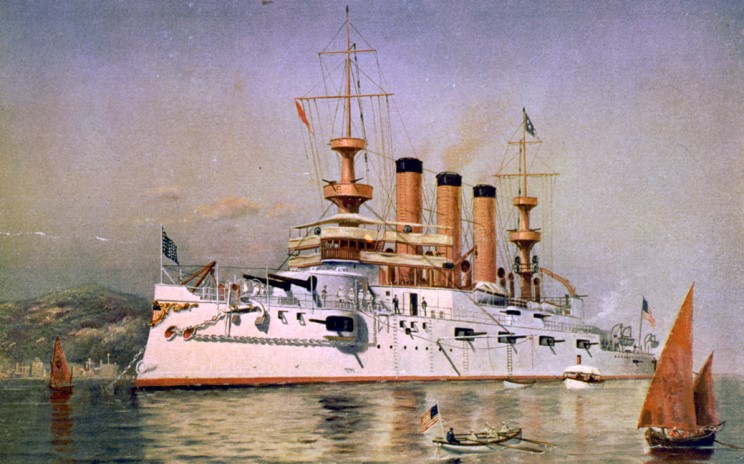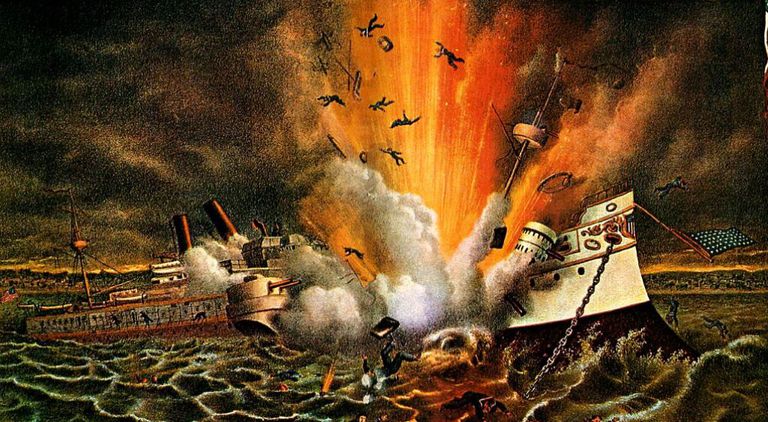 |
| USS Maine |
At 9:40 P.M. on 15 February 1898, the USS Maine, moored in Havana Harbor, Cuba, exploded, killing 266 men. The destruction took place in an already tense situation between Spain, which had imperial control over Cuba, and the United States, where sympathy for Cuban independence was strong.
The cause of the explosion was not immediately apparent, and in the United States speculation that it was perpetrated by the Spanish was rife, a theory that was actively promoted by the sensationalist press.
Although war between Spain and the United States was probably inevitable, the sinking of the Maine and the theory that Spain had caused it led to an overwhelming public sentiment in favor of war and the avenging of the Maine. The Spanish-American War began on 24 April 1898, after Congress recognized Cuban independence on 20 April. The slogan “Remember the Maine!” was to be a popular one in rallying U.S. support for the war.
  |
The United States had taken an interest in Cuba since the middle of the nineteenth century when Cuban nationalists began to fight for independence. Motivations for this interest were numerous: sympathy for the goal of independence and freedom from a corrupt Old World power (a long cherished American ideal); humanitarian interest in the state of the Cuban people; and economic interests in trade with, and assets in, Cuba.
The U.S. people supported the Cubans’ struggle and provided them with money, guns, and supplies. The Cleveland administration was reluctant to intervene, but when William McKinley assumed the presidency in 1897, the push for intervention became stronger.
Diplomatic events in 1898 revealed Spain’s unwillingness to negotiate with the United States over the Cuban situation. It was also unclear just what the U.S. demanded from Spain—many in the administration were unsure whether Cubans were capable of governing themselves.
A letter from the Spanish ambassador, Dupuy de Lôme, was published in the William Randolph Hearst newspaper the New York Journal on 9 February. In the letter de Lôme insulted President McKinley, outraging the American public. Only six days later, news came that the Maine, which had been sent to Havana in January as an ostensibly friendly gesture, had been sunk.
The Maine had been commissioned as a battleship (although it was originally classified as an armored cruiser) on 17 September 1895. Her captain in 1898 was Charles D. Sigsbee, who sent the note to Washington informing them of the disaster. In part it read: “Maine blown up in Havana Harbor and destroyed.
 |
| USS Maine explosion |
Many wounded and doubtless more killed and drowned .... Public opinion should be suspended until further report” (March, 316). Despite Sigsbee’s plea against jumping to conclusions and the refusal of the U.S. government to speculate on the cause of the explosion, public opinion began to make its own judgment, inflamed by the “yellow press” of Hearst and his rival, Joseph Pulitzer.
Pulitzer’s New York World of 17 February 1898 ran the headline, “Maine Explosion Caused by Bomb or Torpedo?” with a graphic illustration of the Maine exploding (complete with bodies being thrown from the ship) beneath.
Articles quoted “experts” speculating that “a torpedo was used,” and the wounded survivors of the Maine expressed their opinion that it was “a deep laid plot of Spaniards.” Three days later, Sigsbee himself was quoted as believing “a submarine mine blew up the Maine” (New York World, 20 February 1898).
   |
By 24 February, not even ten days after the explosion, headlines ran in the World that left no doubt that the papers believed that it had been no accident: “Experts at Havana Say Some Great Exterior Force Rent and Sunk the Ship” and “Fifty Physical Proofs that Maine Was Blown Up by a Mine or Torpedo.”
The speculation in the press in the first days after the explosion was based on little actual evidence, but fed into the growing public clamor for action against the Spanish.
The government continued to refuse to comment, instead waiting for the results of the official investigation that had been launched immediately after the disaster. Divers and armor experts were sent to investigate the physical evidence of the wreck, and a Naval Court of Inquiry was held.
The public believed that it would provide concrete evidence of Spanish guilt. At the same time, the Spanish conducted their own investigation (as the Maine had blown up in their territorial waters) and concluded that it was caused by an internal explosion.
On 28 March, the official report was submitted. It concluded that two explosions had occurred: “In the opinion of the Court, the Maine was destroyed by the explosion of a submarine mine, which caused the partial explosion of two or more of her forward magazines.
The Court has been unable to obtain evidence, fixing the responsibility for the destruction of the Maine upon any person or persons” (March, 327). While it was clear that Spain had most to lose in going to war, the public was more than willing to attribute the guilt for this to them.
The neutral findings of the court opened the way to this. The press jumped at the chance to inflame the issue. Hearst’s slogan was “Remember the Maine, and to hell with Spain!” On 22 April, the United States blockaded Cuba, and a day later volunteers were called for.
The theory that the Spanish had sunk the Maine clearly contributed to a strong public opinion encouraged by the press favoring war. While it was not the only factor present in a complicated diplomatic situation, it was a significant one. The Maine remained a patriotic symbol around which support for the war cohered.
What, then, was the “true” story? Admiral H. G. Rickover conducted a new examination into the explosion in 1976. He noted the problems of the original 1898 U.S. inquiry: limited expertise, poor diving conditions in the harbor, and inadequate questioning during the hearings all contributed to an inquiry that was not as comprehensive as it should have been, given the import of its result. Even contemporary experts questioned the likelihood of a mine having been the cause of the disaster.
Public pressure to do something with the Maine wreck led to Congress appropriating $650,000 in 1910 to remove the wreck and recover the bodies still there for burial in Arlington Cemetery. The Army Corps of Engineers were given primary responsibility for the endeavor. In 1911, a new board of investigation arrived in Havana with more expertise than 1898.
They took detailed records of the damage and many photographs and diagrams. Nevertheless, their ultimate conclusion (while differing from 1898 in technical detail) was that the primary explosion was still due to the placing of a mine, which had set off another explosion in the magazines.
For the purposes of Rickover’s study, two experts reexamined all the evidence and concluded that in fact the primary explosion had been an internal one, possibly caused by fire in a bunker setting off explosions in the magazines.
The story of the sinking of the USSMaine is clearly central to the story of the Spanish-American War; but it also raises issues that have to do with the role of the press in creating “conspiracy theories” to suit their purposes (increased circulation and jingoism), as well as the issue of scientific evidence and its role in establishing “truth.” In this story, technical evidence is central in determining the “true” story of the Maine and whether a war was started over an accident.
Certainly the role of technical or scientific evidence continues to be central to society’s need to determine the “truth” of events, but this story also reveals that technical evidence (which is not infallible) can be given too much power. Rickover speculates whether a different outcome might have occurred if the 1898 inquiry had come to a different conclusion.
While that can only ever be hypothesis, it nevertheless raises the issue of just how important the “conspiracy theory” about the Maine—reinforced by the “truth” of a scientific inquiry and the inflammatory actions of the press—was in shaping the course of history.